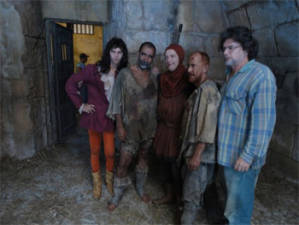Few Lights in Havana
Francisco Castro

I’m not referring to street lighting (which, by the way, is very efficient here – at least in those places where I walk at night). Rather, I’m talking about those lights that should illuminate the way to development and opening, especially in certain centers of cultural power.
I just found out that the feature film Vinci, by the controversial Cuban writer and director Eduardo del Llano, wasn’t accepted into the International Festival of the New Latin American Cinema competition scheduled to hold its 33rd edition during the first eleven days of December in Havana. The reason is that it doesn’t deal with a Latin American issue.
This festival is the country’s most important annual film event — and always the most eagerly awaited — due to the number of important figures and works from all over the world that it is able to gather.
It is a unique opportunity to appreciate what’s happening in the most distant cinematographic worlds, geographically as well aesthetically and qualitatively. The festival offers films that we usually don’t come into contact with, given the fact that we’re typically presented with Americanized movies in our cinemas.
What’s more, the competition screens movies in a 35 mm format, meaning that the quality of what’s shown is almost guaranteed (assuming the projectionists don’t mix up the order of the reels).
It’s also an opportunity to compare films produced here on the island with those created in the rest of the region, which at one glorious moment in history constituted a true “movement” of new Latin American cinema.” (This is no longer the case owing to the enormous diversity of styles, issues and interests presented from one movie to another, and even within the same cinematographic school).
This opportunity is being wasted, disturbingly, because a straightjacketed approach is being applied to the interpretation of the festival’s purpose, which is to “recognize and spread cinematographic works that, based on their significance and artistic values, contribute to enriching and reaffirming Latin American and Caribbean identity” (according to the Havana Film Festival mission statement).
“But what is a Latin American theme?” asked the self-obsessed villager.
Does that purpose perhaps mean keeping alive a movement that has exhibited unequivocal symptoms for many years of, if not of its own disappearance, indeed its own changing, in the sense of expanding its thematic horizons?
From what I’ve been able to appreciate in the six festivals that I’ve attended, the Latin American films selected to compete in Havana have increasingly focused on looking at our own people.
We look at ourselves face to face, in close up, to discover almost identical features in the Latin American being, like those in Asians, Europeans, Africans… It becomes patently obvious that the universal is evident in individual microcosms.
Therefore isn’t a Latin American theme a universal theme?
Obviously not all movies can compete. Operating on a selection criteria that prioritizes the artistic quality of the work and its contribution to enriching our identity, there’s no doubt that one could make a selection easily – but what makes a theme be valid or not?
Does a movie whose drama is centered in the great question of “what beauty serves and its importance for the human being” contribute to the enrichment and reaffirmation of Latin American and Caribbean cultural identity?
Is any reflection made about beauty and intolerance perhaps overstepping all boundaries? Or is it that the movie, instead of revolving around the universal figure of Leonardo da Vinci, should have as its leading character the poet-king Netzahualcoyotl?
What identifies us, here at the beginning of the 21st century, as Latin American and Caribbean? And what enriches us?
It will be necessary to turn on the lights that illuminate the way to opening and inclusion. This supposes individual enrichment and development, which also means collective enrichment and development.





